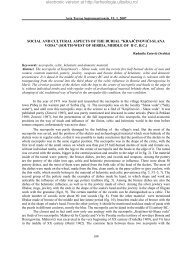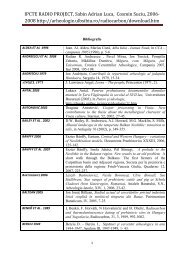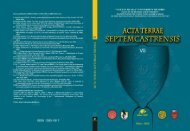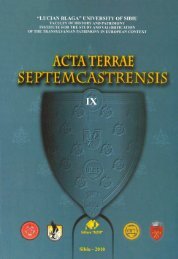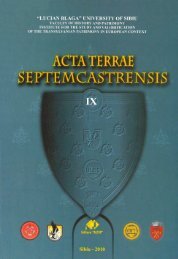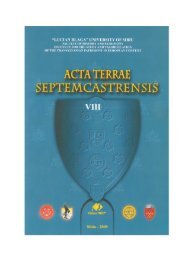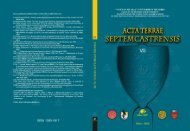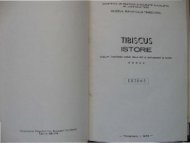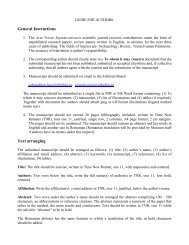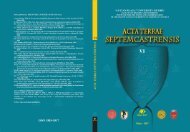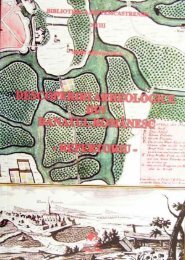acta terrae septemcastrensis viii - Institutul pentru cercetarea Åi ...
acta terrae septemcastrensis viii - Institutul pentru cercetarea Åi ...
acta terrae septemcastrensis viii - Institutul pentru cercetarea Åi ...
You also want an ePaper? Increase the reach of your titles
YUMPU automatically turns print PDFs into web optimized ePapers that Google loves.
Acta Terrae Septemcastrensis, VIII, 2009<br />
Ukraine:<br />
Czech Republic:<br />
Kosovo:<br />
Čapaevka and Aleksandrovka.<br />
Mohelnice.<br />
Fafos.<br />
Some final sites of local relevance are Vésztò–Magor, Lozna, Bazovets, Gorna<br />
Beshovitsa, Suplacu de Barcău, Cífer–Pác, Drama–Merdzhumekja, Ballenstedt,<br />
Suceveni, Hotărani, Gomolava, Bina, Butmir, Hotnitsa–Orlovka, Kisunyom–<br />
Nàdasi, Sé, Aszód, Valač, Ribnjak–Bečei, Vršnik, Battonya, Gyor Szabadret,<br />
Szegvàr–Türköves, Kisköre, Valea Nandrului, Tangâru, and Lepenska potkapina.<br />
The other settlements were sporadic exploiters of the sign system.<br />
Expanding upon the subject of the hubs of the Danube script, a corpus of<br />
704 signs is attributed to Vinča. These signs belong to the long period spanning the<br />
Accumulative stage to the Stamina stage. 6 The Blooming stage and the<br />
Accumulative stage provided the most evident, and equivalently significant,<br />
contributions. During the Stamina stage, the script concentration declined,<br />
subsequently leading to an abrupt eclipse. At Vinča the most frequently inscribed<br />
objects are human figurines: 29.4% of the total. About 51.3% of them belong to<br />
the Late Neolithic, 25.0% to the Middle/Developed Neolithic and 23.7% to the<br />
Early Copper Age. In 50% of the cases, the anthropomorphic representations are<br />
asexual or have not distinct gender features. In 33.1% of the instances, gender is<br />
unknown. Only 15.1% of the figurines show clear female attributes. The<br />
contribution from potshards is 21.5%. The number of findings for mignon<br />
altars/offering tables is also significant: 16.2%. The signs are usually inscribed on<br />
their walls. The input from miniaturized vessels, which are mainly inscribed on the<br />
rim/upper body, is 9.0%. A fourth kind of inscribed artifacts are vessels, 6.1%,<br />
which are always inscribed on the rim/upper body. Residual contributions have<br />
come from animal figurines (2.9%) and plate-tablets (1.7%). DatDas has no record<br />
of any altar, spindle-whorl or amulet bearing signs from Vinča.<br />
Turdaş lists 537 signs (9.9% of the montant global), all concentrated in the<br />
Blooming stage of the script. In the Late Neolithic, Turdaş acquired a starring<br />
leading role, accounting for 22.2% of the signs, whereas Vinča was subjected to an<br />
evident crisis and fell to 7.9%. The Turdaş culture played a pivotal role in the<br />
blossoming and spread of literacy in Neolithic and Copper Age Southeastern<br />
Europe, but was not in the genesis of it.<br />
A comparison of the occurrence figures of the Turdaş and Vinča signs yields<br />
significant results, because at Turdaş, the range of the inscribed artifacts is much<br />
wider than at Vinča although 41.3% of the signs are concentrated on potshards.<br />
The contribution from spindle-whorls is 20.9%. The input from anthropomorphic<br />
figurines is 8.2%. In 29.6% of the instances, they are asexual or without distinct<br />
sexual attributes; in 27.3%, they have obvious female features; in 15.9%, they<br />
show a male aspect. For the remaining figurines, sex is unknown. Signs have been<br />
found to a lesser degree on mignon altars/offering tables (4.5%), mignon vessels<br />
(4.3%), those with inscriptions on their walls (54.2%) and legs (45.8%). Less<br />
6 DatDas inserts the Vinča A stage in the Accumulative stage of the Danube script.<br />
47



